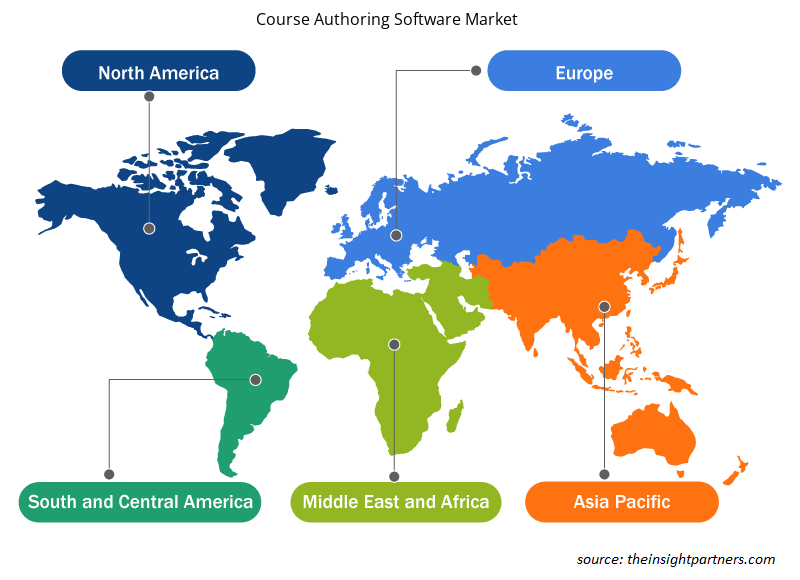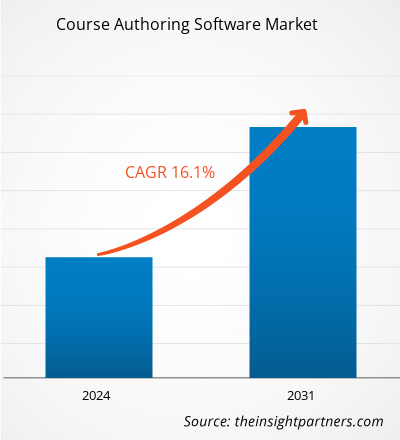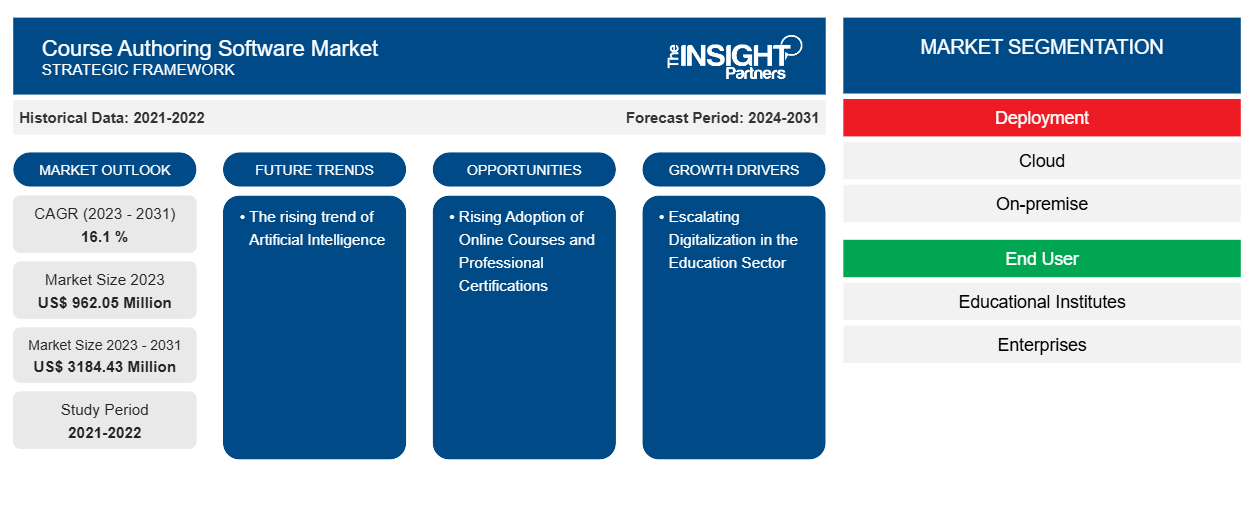Der Markt für Kurserstellungssoftware soll von 962,05 Millionen US-Dollar im Jahr 2023 auf 3.184,43 Millionen US-Dollar im Jahr 2031 anwachsen. Für den Zeitraum 2023–2031 wird für den Markt eine durchschnittliche jährliche Wachstumsrate (CAGR) von 16,1 % erwartet.Der steigende Trend zur künstlichen Intelligenz wird voraussichtlich ein wichtiger Trend auf dem Markt für Kurserstellungssoftware bleiben.
Marktanalyse für Kurserstellungssoftware
Die zunehmende Digitalisierung des Bildungssektors ist ein Faktor, der das Wachstum des Marktes für Kurserstellungssoftware vorantreiben könnte. Kurserstellungssoftware wird im Bildungssektor weithin eingesetzt, um das Lernen und die Ergebnisse zu verbessern. Ed-Tech-Unternehmen, Bildungseinrichtungen und Organisationen verwenden Geräte wie Smartphones , Tablets, VR- und AR-Geräte, digitale interaktive Displays, Smartgeräte und Smartphones zum Zweck des Unterrichts und der Inhaltserstellung. Andere Tools wie virtuelles Lernen, Edutainment, Online-Lernkurse, Online-Bewertungen und digitale Zeitschriften treiben die zunehmende Nutzung digitaler Technologien ebenfalls voran.
Marktübersicht für Kurserstellungssoftware
Ausbilder, Trainer und andere Pädagogen verwenden Kurserstellungssoftware, um Unterrichtsmaterialien zu erstellen, zu organisieren und zu verbreiten. Mithilfe dieses Programms können Benutzer interaktive Kurse und Vorlesungen erstellen, die Text, Grafiken, Fotos, Videos, Audio, Simulationen und Aktivitäten enthalten. Funktionen wie die Verwaltung von Lerninhalten, die Erstellung von Inhalten, Tests und die Überwachung des Lernfortschritts sind häufig ebenfalls in Kurserstellungssoftware enthalten. Die Nachfrage nach effektiven und erschwinglichen Möglichkeiten zur Bereitstellung von Online-Lernen befeuert den Wettbewerb auf dem globalen Markt für Kurserstellungssoftware.
Passen Sie diesen Bericht Ihren Anforderungen an
Sie erhalten kostenlose Anpassungen an jedem Bericht, einschließlich Teilen dieses Berichts oder einer Analyse auf Länderebene, eines Excel-Datenpakets sowie tolle Angebote und Rabatte für Start-ups und Universitäten.
-
Holen Sie sich die wichtigsten Markttrends aus diesem Bericht.Dieses KOSTENLOSE Beispiel umfasst eine Datenanalyse von Markttrends bis hin zu Schätzungen und Prognosen.
Markttreiber und Chancen für Kurserstellungssoftware
Zunehmende Digitalisierung im Bildungsbereich
Ausbilder, Trainer und andere Pädagogen nutzen Kurserstellungssoftware, um Unterrichtsmaterialien zu erstellen, zu organisieren und zu verbreiten. Mithilfe dieses Programms können Benutzer interaktive Kurse und Vorlesungen erstellen, die Text, Grafiken, Fotos, Videos, Audio, Simulationen und Aktivitäten enthalten. Funktionen wie die Verwaltung von Lerninhalten, die Erstellung, Prüfung und Überwachung des Lernfortschritts sind häufig ebenfalls in Kurserstellungssoftware enthalten. Die Nachfrage nach effektiven und erschwinglichen Möglichkeiten zur Bereitstellung von Online-Lernen befeuert den Wettbewerb auf dem globalen Markt für Kurserstellungssoftware. Die zunehmende Nutzung mobiler Geräte, der Bedarf an digitalen Lernressourcen, die Verfügbarkeit von Open-Source-Kurserstellungssoftware und die Einführung neuer Technologien wie virtuelle Realität und künstliche Intelligenz sind alles Faktoren, die
Steigende Nutzung von Online-Kursen und professionellen Zertifizierungen
Zu den Vorteilen der Verwendung von Kurserstellungssoftware gehören die Peer-to-Peer-Problemlösung und kostenloses Material. Benutzer können mit Kurserstellungssoftware Inhalte erstellen und zu einer gemeinsamen Lernumgebung hinzufügen. Benutzer können mithilfe einer Vielzahl von Content-Management-Systemen (CMS) Inhalte für eine gemeinsame Lernumgebung erstellen und beitragen. Diese Tools umfassen normalerweise Tools zur Unterstützung bei der Verwaltung von Inhaltsgenehmigungen und -aktualisierungen sowie Vorlagen oder Themen, die Benutzern dabei helfen, eine optisch ansprechende und einheitliche Lernumgebung zu erstellen. Darüber hinaus verfügen viele CMS über soziale Funktionen, mit denen Benutzer gemeinsam an Projekten arbeiten und Inhalte mit anderen Mitgliedern der Community austauschen können. Beliebte Content-Management-Systeme (CMS), die die Kurserstellung unterstützen, sind Moodle, Drupal und WordPress. Daher wird erwartet, dass die zunehmende Einführung von Online-Kursen und professionellen Zertifizierungen den Akteuren auf dem Markt für Kurserstellungssoftware im Prognosezeitraum neue Möglichkeiten bietet.CMS). These tools usually include tools to assist with managing content approvals and updates, as well as templates or themes to assist users in creating a visually appealing and unified learning environment. Furthermore, a lot of CMSs come with social capabilities that let users work together on projects and exchange content with other members of the community. Popular content management systems (CMSs) that support course authoring are Moodle, Drupal, and WordPress. Thus, the rising adoption of online courses and professional certifications is anticipated to present new opportunities for the course authoring software market players during the forecast period.
Marktbericht zur Kurserstellungssoftware – Segmentierungsanalyse
Wichtige Segmente, die zur Ableitung der Marktanalyse für Kurserstellungssoftware beigetragen haben, sind Bereitstellung und Endbenutzer.
- Basierend auf der Bereitstellung ist der Markt für Kurserstellungssoftware in Cloud und On-Premise segmentiert. Das Cloud-Segment hatte im Jahr 2023 einen größeren Marktanteil.
- Nach Endbenutzern ist der Markt in Bildungseinrichtungen und Unternehmen segmentiert.
Marktanteilsanalyse für Kurserstellungssoftware nach geografischer Lage
Der geografische Umfang des Marktberichts zur Kurserstellungssoftware ist hauptsächlich in fünf Regionen unterteilt: Nordamerika, Asien-Pazifik, Europa, Naher Osten und Afrika sowie Südamerika/Süd- und Mittelamerika. In Bezug auf den Umsatz hatte Nordamerika den größten Marktanteil im Bereich der Kurserstellungssoftware. Aufgrund der Existenz von Cloud-Dienstanbietern, Herstellern von Smart-Geräten, Anbietern von Kurserstellungssoftware und anderen Branchenakteuren sowie weit verbreiteter technologischer Fortschritte in diesem Bereich bei Unternehmensorganisationen und Bildungseinrichtungen gab es in Nordamerika einen deutlichen Anstieg des Investitionswachstums für Bildungstechnologiedienste und -lösungen.
Regionale Einblicke in den Markt für Kurserstellungssoftware
Die regionalen Trends und Faktoren, die den Markt für Kurserstellungssoftware während des Prognosezeitraums beeinflussen, wurden von den Analysten von Insight Partners ausführlich erläutert. In diesem Abschnitt werden auch die Marktsegmente und die Geografie von Kurserstellungssoftware in Nordamerika, Europa, im asiatisch-pazifischen Raum, im Nahen Osten und Afrika sowie in Süd- und Mittelamerika erörtert.

- Erhalten Sie regionale Daten zum Markt für Kurserstellungssoftware
Umfang des Marktberichts zur Kurserstellungssoftware
| Berichtsattribut | Details |
|---|---|
| Marktgröße im Jahr 2023 | 962,05 Millionen US-Dollar |
| Marktgröße bis 2031 | 3184,43 Millionen US-Dollar |
| Globale CAGR (2023 - 2031) | 16,1 % |
| Historische Daten | 2021-2022 |
| Prognosezeitraum | 2024–2031 |
| Abgedeckte Segmente |
Nach Bereitstellung
|
| Abgedeckte Regionen und Länder |
Nordamerika
|
| Marktführer und wichtige Unternehmensprofile |
|
Dichte der Marktteilnehmer für Kurserstellungssoftware: Die Auswirkungen auf die Geschäftsdynamik verstehen
Der Markt für Kurserstellungssoftware wächst rasant, angetrieben durch die steigende Nachfrage der Endnutzer aufgrund von Faktoren wie sich entwickelnden Verbraucherpräferenzen, technologischen Fortschritten und einem größeren Bewusstsein für die Vorteile des Produkts. Mit steigender Nachfrage erweitern Unternehmen ihr Angebot, entwickeln Innovationen, um die Bedürfnisse der Verbraucher zu erfüllen, und nutzen neue Trends, was das Marktwachstum weiter ankurbelt.
Die Marktteilnehmerdichte bezieht sich auf die Verteilung von Firmen oder Unternehmen, die in einem bestimmten Markt oder einer bestimmten Branche tätig sind. Sie gibt an, wie viele Wettbewerber (Marktteilnehmer) in einem bestimmten Marktraum im Verhältnis zu seiner Größe oder seinem gesamten Marktwert präsent sind.
Die wichtigsten auf dem Markt für Kurserstellungssoftware tätigen Unternehmen sind:
- Articulate Global Inc
- Brainshark Inc
- Easygenerator BV
- Erläutern
- iSpring Solutions, Inc
- LearnWorlds (CY) Ltd
Haftungsausschluss : Die oben aufgeführten Unternehmen sind nicht in einer bestimmten Reihenfolge aufgeführt.

- Überblick über die wichtigsten Akteure auf dem Markt für Kurserstellungssoftware
Neuigkeiten und aktuelle Entwicklungen zum Markt für Kurserstellungssoftware
Der Markt für Kurserstellungssoftware wird durch die Erfassung qualitativer und quantitativer Daten nach Primär- und Sekundärforschung bewertet, die wichtige Unternehmensveröffentlichungen, Verbandsdaten und Datenbanken umfasst. Im Folgenden finden Sie eine Liste der Entwicklungen auf dem Markt für Sprach- und Sprechstörungen und -strategien:
- Im März 2022 kündigte Intellum, die führende Bildungsplattform für Kunden, Partner und Mitarbeiter, eine umfassende Neugestaltung von Evolve an, dem weltweit innovativsten Tool zur Inhaltserstellung, das von einer Vielzahl von Unternehmen verwendet wird, darunter Google, Meta, Salesforce, Randstad, Pearson, WeWork und Cotton On. (Quelle: Intellum, Pressemitteilung)
- Im Dezember 2020 kündigte Absorb Software, Anbieter des branchenführenden Absorb Learning Management Systems (LMS), die Veröffentlichung seines neuen Kurserstellungstools Absorb Create an. (Quelle: Absorb Software, Pressemitteilung)
Marktbericht zur Kurserstellungssoftware – Umfang und Ergebnisse
Der Bericht „Marktgröße und Prognose für Kurserstellungssoftware (2021–2031)“ bietet eine detaillierte Analyse des Marktes, die die folgenden Bereiche abdeckt:
- Marktgröße und Prognose auf globaler, regionaler und Länderebene für alle wichtigen Marktsegmente, die im Rahmen des Projekts abgedeckt sind
- Marktdynamik wie Treiber, Beschränkungen und wichtige Chancen
- Wichtige Zukunftstrends
- Detaillierte PEST/Porters Five Forces- und SWOT-Analyse
- Globale und regionale Marktanalyse mit wichtigen Markttrends, wichtigen Akteuren, Vorschriften und aktuellen Marktentwicklungen
- Branchenlandschaft und Wettbewerbsanalyse, einschließlich Marktkonzentration, Heatmap-Analyse, prominenten Akteuren und aktuellen Entwicklungen
- Detaillierte Firmenprofile
- Historische Analyse (2 Jahre), Basisjahr, Prognose (7 Jahre) mit CAGR
- PEST- und SWOT-Analyse
- Marktgröße Wert/Volumen – Global, Regional, Land
- Branchen- und Wettbewerbslandschaft
- Excel-Datensatz
Aktuelle Berichte
Verwandte Berichte
Erfahrungsberichte
Grund zum Kauf
- Fundierte Entscheidungsfindung
- Marktdynamik verstehen
- Wettbewerbsanalyse
- Kundeneinblicke
- Marktprognosen
- Risikominimierung
- Strategische Planung
- Investitionsbegründung
- Identifizierung neuer Märkte
- Verbesserung von Marketingstrategien
- Steigerung der Betriebseffizienz
- Anpassung an regulatorische Trends























 Kostenlose Probe anfordern für - Markt für Kurserstellungssoftware
Kostenlose Probe anfordern für - Markt für Kurserstellungssoftware